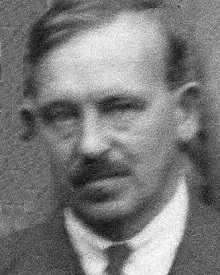Ralph H. Fowler facts for kids
Quick facts for kids
Ralph Howard Fowler
|
|
|---|---|

Fowler in 1934
|
|
| Born | 17 January 1889 Fedsden, Roydon, Essex, England
|
| Died | 28 July 1944 (aged 55) Trumpington, Cambridgeshire, England
|
| Alma mater | Trinity College, Cambridge |
| Known for | Fowler–Nordheim-type equations Fowler–Nordheim tunneling Darwin-Fowler method Bernal–Fowler rules Field electron emission Degenerate stars |
| Awards | Rayleigh Prize (1913) Adams Prize (1924) Royal Medal (1936) Fellow of the Royal Society |
| Scientific career | |
| Fields | Statistical physics |
| Institutions | Cambridge University |
| Academic advisors | Archibald Vivian Hill |
| Doctoral students | Garrett Birkhoff S. Chandrasekhar Paul Dirac Wang Zhuxi Homi J. Bhabha Douglas Rayner Hartree John Lennard-Jones Harrie Massey William McCrea Nevill Francis Mott Maurice Pryce Bertha Swirles |
Sir Ralph Howard Fowler (1889–1944) was a brilliant British scientist. He was a physicist, an astronomer, and a physical chemist. He made important discoveries about how matter behaves, especially at very small scales or in extreme conditions like inside stars.
Contents
Early Life and Education
Ralph Howard Fowler was born in Roydon, Essex, England, on January 17, 1889. His father was Howard Fowler, and his mother was Frances Eva. He first learned at home before going to schools like Horris Hill and Winchester College.
He was very good at math. He earned a scholarship to study mathematics at Trinity College, Cambridge. There, he became a "wrangler," which means he achieved one of the highest scores in the difficult math exams at Cambridge.
Service During Wartime
During World War I, Fowler joined the Royal Marines. He was badly hurt in his shoulder during a battle in Gallipoli. Because of his injury, he could not fight on the front lines anymore.
His friend, Archibald Vivian Hill, found a way for Fowler to use his amazing math skills. Fowler worked on how to aim anti-aircraft guns at planes. He helped improve how shells flew through the air, especially spinning ones. For his important work, he received the Order of the British Empire (OBE) in 1918.
When World War II started, even though he was not well, he again helped the country. He worked with the Ordnance Board, which deals with military weapons. He also helped share scientific information between Britain, Canada, and the United States. Because of this vital work, he was made a knight in 1942, earning the title "Sir."
Academic Achievements
After World War I, Fowler went back to Cambridge University in 1919. He became a math lecturer in 1920. He focused on thermodynamics (the study of heat and energy) and statistical mechanics (how the behavior of tiny particles affects the properties of large objects). He brought new ideas to the field of physical chemistry.
- Working with Other Scientists
Fowler worked with many famous scientists:
- With his friend Arthur Milne, he wrote an important book about stars. They studied how hot stars are and what they are made of.
- In 1925, he became a Fellow of the Royal Society, a very respected group of scientists.
- He guided the research of Paul Dirac, who later won a Nobel Prize. In 1926, they studied white dwarf stars. These are very dense, small stars.
- In 1927, he attended the fifth Solvay Conference on Physics. This was a meeting of the world's top physicists in Belgium.
- In 1928, with Lothar Wolfgang Nordheim, he explained a process called field electron emission. This helped prove a modern theory about how electrons behave in materials.
- In 1931, he was the first to clearly state the zeroth law of thermodynamics. This law explains that if two objects are each in thermal balance with a third object, then they are also in thermal balance with each other.
- In 1932, he became the Professor of Theoretical Physics at the Cavendish Laboratory at Cambridge.
- In 1933, he worked with John Bernal to create a model for the structure of water and ice, known as the ice rules.
Fowler was an amazing teacher and mentor. Between 1922 and 1939, he guided the studies of 64 doctoral students. Many of them became very successful scientists, including three who won Nobel Prizes: Subrahmanyan Chandrasekhar, Paul Dirac, and Nevill Francis Mott. He also introduced Dirac to the ideas of quantum theory.
Personal Life
Fowler enjoyed playing cricket in his free time. He was a wicket-keeper for Norfolk County Cricket Club in 1908 and 1909.
In 1921, he married Eileen Mary. She was the only daughter of Ernest Rutherford, another famous scientist who won a Nobel Prize. Ralph and Eileen had four children together. Sadly, Eileen passed away in 1930 after the birth of their last child, Ruth.
One of his grandchildren, Mary Fowler, also became a respected scientist. She is a geophysicist.
The Fowler Islands in Antarctica were named in his honor, showing how important his contributions to science were.
See also
 In Spanish: Ralph H. Fowler para niños
In Spanish: Ralph H. Fowler para niños
Images for kids


